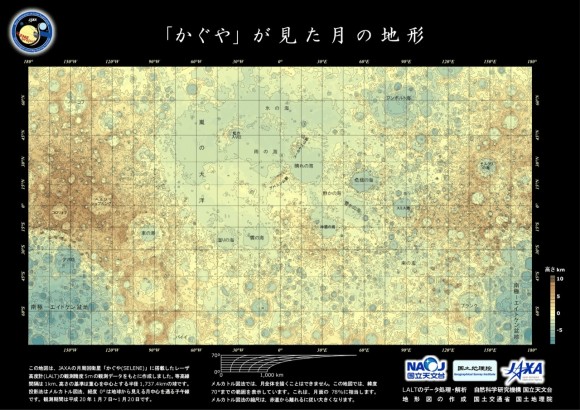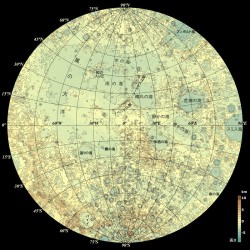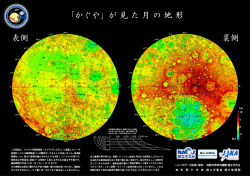The Japanese SELENE lunar orbiter has returned some of the most detailed maps of the Moon to date. The new collection of high-definition maps includes topological data and mineral location. Critically, the locations of uranium, thorium and potassium have been mapped, essential for mission planners when considering the future of manned settlements on the Moon. Seeing the lunar relief mapped to such fine detail makes for an impressive sight. So far six million data points have been collected and there’s more to come…

The SELENE mission was launched on September 14th, 2007 from Tanegashima Space Center on a H-IIA carrier rocket. SELENE stands for “Selenological and Engineering Explorer”, but Selene was also the Greek lunar deity. The orbiter arrived into lunar orbit on October 3rd and began science operations soon after. Since then, the spacecraft has been using a large number of instruments to characterise the surface of the Moon from analysing its mineral distribution to measuring its terrain. It has been described as the largest Moon mission since the US Apollo program.

According to the JAXA press release, these new maps are ten-times more accurate than previous maps. Using the laser altimeter (LALT) instrument, 3D data of the shapes and altitudes of surface features are promising to give the most advanced relief mapping capabilities ever performed on a planetary body other than the Earth. It has also been indicated that deposits of uranium, potassium and thorium have been pinpointed through the use of one of its onboard spectrometers. This will have massive implications for the future of manned exploration of the natural satellite. It is likely that a nuclear source of energy would be required for future lunar settlements, if there are quantities of uranium to be mined, this will have an impact on where the settlement should be located.

So, when venturing out onto the cold, lonely lunar surface, be sure to pack the newest edition of the Selene high-definition map to plot your journey…
13 Replies to “Japanese Moon Mission Returns Detailed Maps of the Lunar Surface”
Comments are closed.


Thank you Jim for that insight, very good point – I was interested to know about the implications behind finding these elements, an excellent addition to the article. Thanks!
Cheers, Ian
While JAXA say that the map produced is upto ten times more accurate, the current image produced wouldn’t be considered a bench-mark. Several main craters and other well-known features shown (NB for a closer image see http://wms.kaguya.jaxa.jp/data/jpn/lalt/004/lalt_004_2.gif ) don’t show any substantial detail of what we’ve been used to. However, over the coming months the accuracy is expected to improve as another instrument onboard — the Terrain Camera (a high spatial resolution stereoscopic camera) works alongside the LALT.
John — http://www.moonposter.ie
Moon News: http://www.moonposter.ie/news.htm
Moon Missions: http://www.moonposter.ie/missions.htm (Kaguya, Chang’e-1, Chandrayaan-1, LRO, GRAIL & LADEE, LunaGlob, LEO, MoonLITE):
(e-mail messages are checked by anti-virus software before delivery)
Actually even if nuclear fission wasn’t a potential energy source for space use, checking for uranium thorium & potassium would have been done.
Those 3 elements are easy to look for because they have isotopes (or isotopes with decay products) that emit gamma rays of known energy. One can look for the gamma ray by putting a suitable detector in a satellite for an airless body like the moon, or a low flying aircraft for a body with an atmosphere like the earth.
Aside from telling us directly the concentration of U Th & K, the amounts of those elements & their ratios give clues to the geology of the region & where other elements that don’t emit gamma rays might be concentrated.
In the 1980s when I was helping turn such airborne gamma ray data into maps, nobody was prospecting for uranium, but it was useful for finding other elements.
Good article, thanks!
I heard recently about the presence of Helium3 in the lunar regolith – The cleanest nuclear reaction possible, but no mention of it here. Any ideas?
These topographical maps, indicating mineral deposits (ah, would they mention gold?) will one day have the same historic value as do maps from the Lewis and Clark Expedition.
Lewis and Clark expedition.Very right thinking.
Well the earth was quite nice before we started to wreck it and kill the animals and junk. But there really isn’t anythong on the moon to destroy appart from the view. So long as we bury all our junk and keep up appearences whats the big deal? I mean a single crater on the moon might even bee a good place for us to dump all our radio active watse. Whats is there on the moon that will be harmed by it?
Dump crap on the moon. The moon is possibly one of the main reasons life on earth started and continues to exist. We should treat it with great respect. As we should the sphere we live on, but don’t.
Anyone know when the detailed maps of the far side of the moon will be available for public viewing. I am curious to see if it can finally be proven that there is or is not a cigar shaped “space craft” on the far side of the moon. Do a google search on retiredafb to see. Facinating even if it is a hoax.
ROFLMAF! If there were a “cigar shaped space craft” on the far side of the moon, do you really think they’d stick around and smile for the camera? Perhaps they’ll also find that the moon is hollow and Elvis lives there. LOL!
I saw a cable special that said that there are hot spots on the facing side of the moon with high density , on the other side the same of low density . What if while the moon was semi-molten large astroids pushed through and that is where the lava flows came from . any way of contacting the japanese scientist that was on that special ?
where are the photos !!!!
could he be right
earth shine does not make sense
earth is not a polished
but glass can refract light around a curved surface
earth is not a polished mirror
earth is not a cosmic flashlight
but all and all where are the photos we have photos of mars we have photos of earth we have old photos of the moon
we have new maps of the moon how do you make a map with out an imaging device so where are the photos